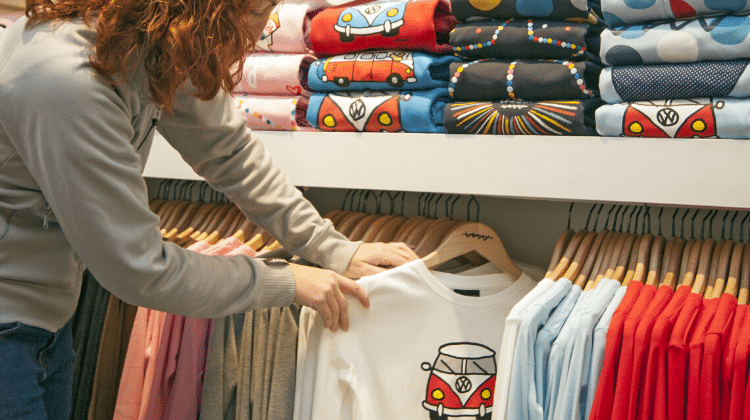
Brought to you by Thrive Screen Printing:
T-shirt printing is definitely an art. Although shirt or garment printing does require a certain level of skill, that doesn’t mean there’s only one way to get the job done. In fact, there are several ways to print amazing logos, designs, and graphics on T-shirts.
Of course, you always want to go with the method that will make your shirt stand out, but how do you know which type that is exactly? Well, the answer is somewhat complicated. The better question might be, “Which available type of shirt/garment printing process will work best for a specific project?”
Obviously, to answer either question, you need to know what the various types of garment printing are and when each technique should be used. Let’s go over the available kinds of t-shirt printing and their uses.
Direct to Garments (DTG)
One highly popular way to print designs on T-shirts is called direct to garment printing. This particular method involves spraying the ink onto the fabric/garment. This is essentially printing on cloth instead of paper.
Many printing professionals opt for DTG printing when they’re dealing with complex designs and intricate logos. Moreover, there’s a wealth of color options for DTG. Therefore, the sky is truly the limit when using this technique.
This is also a great option if you’re in a time crunch and would like to use a printing method that doesn’t require a lot of setup time. DTG is also extremely eco-friendly and helps prevent overproduction. If you’re interested in DTG for your company T-shirts, then you should check out your local go direct to garment printing resources to explore your options.
Screenprinting
Another widely used method for T-shirts and apparel is screenprinting. This specific type of printing is more common than DTG. Screenprinting is where ink is pushed through a woven screen/mesh stencil. Here, the ink lays on top of the t-shirt or fabric and doesn’t soak into your materials like the previous printing method.
With that said, screenprinting works better with simple designs, graphics, and logos. One of the main reasons is that designs are transferred in layers. As a result, the more complicated the design is, the more layers it will require (i.e., more custom screens will need to be created to achieve the desired look). Thus, as one would expect, printing with a screen does take longer and should be used for bulk orders, not a single shirt.
Take note that screenprinting uses a lot of resources like multiple inks, tons of water, and so on. Therefore, it’s not the most eco-friendly option available. Typically, this form of printing is best for simple shapes, blocks of colors, and straightforward designs with less than nine colors.
Plastisol Transfer
The plastisol transfer technique is screenprinting with an additional step. Instead of ink being transferred to a screen and subsequently, to a shirt, the ink goes from a screen to a plastisol transfer, after which the shirt application occurs. If you’re wondering why, well, this additional step means more flexibility when it comes to garment applications. Think of t-shirts, hoodies, sweatshirts, tote bags, and more.
This printing method works well with highly opaque designs on dark fabrics and is economical. You can store these heat transfers for later use, making them another remarkable green or eco-friendly option.
Overall, plastisol transfers create high-quality merchandise, but it’s a time-consuming process, especially when dealing with larger orders. Take note that if transfers aren’t stored properly, they can easily break or crack.
Heat Press
A more traditional and relatively affordable method of printing is heat press. This specific method of T-shirt printing is pretty much what it sounds like — a design is printed on transfer paper, which is then pressed into the garment/fabric via heat and pressure. Typically, the transfer paper has a vinyl template on it, and when heated to the right temperature, the vinyl design fuses to the shirt.
This technique is very basic and works best for smaller orders with intricate yet durable designs and light-colored fabrics. In terms of being eco-friendly, heat press printing is easily one of the better ways to reduce your company’s carbon footprint.
Vinyl Cutting
Vinyl cutting for T-shirts is very similar to heat press printing. However, individual letters or shapes are cut by machine and then transferred to the garment or fabric. Though this is considered another T-shirt printing method, it’s really just a version of the heat press process. Therefore, it’s also eco-friendly and cost-effective.
That said, one notable difference here is that vinyl cutting can be used on a variety of fabrics and materials. This type of T-shirt printing isn’t ideal for larger orders, big graphics, or fabrics that are highly sensitive to elevated heat levels.
Dye Sublimation
Alternatively, dye sublimation is a tad more expensive. People are willing to incur this cost because this technique produces a rather superior product. This method is great for polyester or similar fabrics.
The dye sublimation process involves a little science — inks are turned into a gaseous state, almost like dry ice, then transferred to a polyester garment. Some heat is used to make the design permanent.
Via this process, polyester shirts can achieve sharp and crisp designs. Plus, dye sublimation is the most eco-friendly option available. Under no circumstances should this method be used on cotton shirts or fabrics.
Computer-Aided Design (CAD) Cut Printing
Finally, professional printers also use computer-aided design (CAD) cut printing technique for T-shirts. Here, the selected design is cut from various colored sheets of vinyl onto a screen. This process is controlled by a computer for a precise look. Once the desired looked is achieved, then the artwork is heat-sealed to the shirt or garment.
The CAD technique is typically used with company logos, sportswear, and simple yet bold designs. This is a cost-effective option for bulk orders and produces durable merchandise, though it isn’t the greenest or most eco-friendly method.